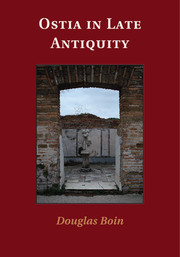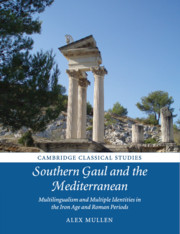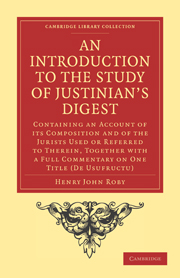Refine search
Actions for selected content:
23990 results in Ancient history
Southern Gaul and the Mediterranean - Title page
-
-
- Book:
- Southern Gaul and the Mediterranean
- Published online:
- 05 July 2013
- Print publication:
- 11 July 2013, pp iii-iii
-
- Chapter
- Export citation
Appendix 2 - List of Greek inscriptions of France not included inIGF
-
- Book:
- Southern Gaul and the Mediterranean
- Published online:
- 05 July 2013
- Print publication:
- 11 July 2013, pp 316-327
-
- Chapter
- Export citation
Copyright page
-
- Book:
- Southern Gaul and the Mediterranean
- Published online:
- 05 July 2013
- Print publication:
- 11 July 2013, pp iv-iv
-
- Chapter
- Export citation
2 - Language contact and communitydynamics
- from Part I - Multilingualism and multiple identities: interdisciplinary methodologies
-
- Book:
- Southern Gaul and the Mediterranean
- Published online:
- 05 July 2013
- Print publication:
- 11 July 2013, pp 53-73
-
- Chapter
- Export citation
Notes on the text
-
- Book:
- Southern Gaul and the Mediterranean
- Published online:
- 05 July 2013
- Print publication:
- 11 July 2013, pp xvi-xvi
-
- Chapter
- Export citation

Law and Society in the Age of Theoderic the Great
- A Study of the Edictum Theoderici
-
- Published online:
- 05 July 2013
- Print publication:
- 25 July 2013

Ostia in Late Antiquity
-
- Published online:
- 05 July 2013
- Print publication:
- 22 July 2013

Southern Gaul and the Mediterranean
- Multilingualism and Multiple Identities in the Iron Age and Roman Periods
-
- Published online:
- 05 July 2013
- Print publication:
- 11 July 2013

The Family in Roman Egypt
- A Comparative Approach to Intergenerational Solidarity and Conflict
-
- Published online:
- 05 July 2013
- Print publication:
- 04 July 2013

Architecture, Astronomy and Sacred Landscape in Ancient Egypt
-
- Published online:
- 05 July 2013
- Print publication:
- 22 July 2013

An Introduction to the Study of Justinian’s Digest
- Containing an Account of its Composition and of the Jurists Used or Referred to Therein, Together with a Full Commentary on One Title (De Usufructu)
-
- Published online:
- 05 July 2013
- Print publication:
- 02 February 2011
- First published in:
- 1884
Chapter 10 - Ptolemies and piracy
-
-
- Book:
- The Ptolemies, the Sea and the Nile
- Published online:
- 05 June 2013
- Print publication:
- 04 July 2013, pp 160-171
-
- Chapter
- Export citation
Copyright page
-
- Book:
- The Family in Roman Egypt
- Published online:
- 05 July 2013
- Print publication:
- 04 July 2013, pp iv-iv
-
- Chapter
- Export citation
Chapter 11 - TheNile police in the Ptolemaic period
-
-
- Book:
- The Ptolemies, the Sea and the Nile
- Published online:
- 05 June 2013
- Print publication:
- 04 July 2013, pp 172-184
-
- Chapter
- Export citation
Index
-
- Book:
- The Family in Roman Egypt
- Published online:
- 05 July 2013
- Print publication:
- 04 July 2013, pp 257-262
-
- Chapter
- Export citation
Chapter 3 - Balancing benefits and obligations
-
- Book:
- The Family in Roman Egypt
- Published online:
- 05 July 2013
- Print publication:
- 04 July 2013, pp 58-91
-
- Chapter
- Export citation
Chapter 5 - Polybius and Ptolemaic sea power
-
-
- Book:
- The Ptolemies, the Sea and the Nile
- Published online:
- 05 June 2013
- Print publication:
- 04 July 2013, pp 82-96
-
- Chapter
- Export citation
Chapter 3 - Callicrates of Samos and Patroclus of Macedon, champions of Ptolemaic thalassocracy
-
-
- Book:
- The Ptolemies, the Sea and the Nile
- Published online:
- 05 June 2013
- Print publication:
- 04 July 2013, pp 39-65
-
- Chapter
- Export citation
Chapter 12 - Hellenistic royal barges
-
-
- Book:
- The Ptolemies, the Sea and the Nile
- Published online:
- 05 June 2013
- Print publication:
- 04 July 2013, pp 185-196
-
- Chapter
- Export citation
Chapter 2 - Household structures, marriage patterns, and inheritance strategies
-
- Book:
- The Family in Roman Egypt
- Published online:
- 05 July 2013
- Print publication:
- 04 July 2013, pp 31-57
-
- Chapter
- Export citation
